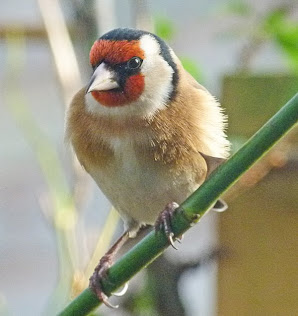You may remember that each year I plant up an annual flower bed on the plot. It provides cut flowers and the bees enjoy it as much as we do.
For the past few years I have raised the seeds in pots and planted them out as described in this post. The end result had been fairly successful even though at the planting out stage things haven't looked too promising.
This year I am trying something different for two reasons, the first being that space in the greenhouse is at a premium and, with fruit and vegetable plants taking priority, the seedlings never really had the best upbringing.
The second reason is that last year I tried some direct sowing and the plants seemed to grow stronger. The reason for the first direct sowing was that I wanted to use up the left over seeds so I mixed them up and sowed them in a trench of compost, just like we sow parsnips and carrots. The seeds were sown in mid-June and resulted in an attractive display of much healthier looking plants.
In retrospect I sowed the seeds too thickly and also I should have considered that some varieties would dominated as the cosmos did and hide the lower growing plants. I should have graded the seeds according to the height that the plants would achieve. Overall though it was a success and continued flowering after the originally planted bed had faded.
This spurred me on to try sowing some hardy annual seeds in autumn to overwinter and hopefully produce earlier flowers. I sowed cornflowers, some larkspur seeds that were a couple of years old, calendula and a packet of mixed annual seeds on 15 September and covered with enviromesh. This was more to protect them from being eaten than to offer protection from the weather.
The seeds germinated in a week and by mid October looked like this.
They continued to grow through November.
In March, when the mesh was removed, the bed looked like this.
The cornflowers were doing well, most of the calendula had been eaten presumably by slugs and the larkspur failed which could have been down to using old seed. As for the mixed seeds, there is a mix of leaf types but until they flower I can't say which varieties have survived. The cornflowers have gone on to produce the strongest looking cornflowers that I have grown and they are already providing cut flowers.
I'm standing by the side of the bed to give an idea of the height that the cornflowers have grown. I am five foot one and a half inches (just over 1.56m). I've always aspired to being five foot two).
The mild winter could have helped the plants to survive and it will be interesting to see what happens next year as I plan to repeat the process again, maybe adding some different varieties to the cornflowers which will be a must. Has anyone any recommendations?
The success with self sown annuals set me thinking, that maybe I have been too soft with the hardy annuals, so this year I decided to try the direct sowing method. I sorted the seeds that I had bought into hardy and half hardy. Some seeds of each of the half hardy varieties have been sown inside as an insurance policy.
The hardy varieties and some seeds from the half hardy types were sown direct in compost trenches on 13 May and some only five days later are already germinating. I've learned for the late summer sowing and have sown each variety of seeds in a patch rather than mixing them together and tried to position smaller varieties in positions where they have less chance of being swamped by cosmos.
No doubt there will be patches in the germination and so indoor sown half hardy annuals will be used to plug the gaps.
As with all gardening it is now wait and see time.
The seeds germinated in a week and by mid October looked like this.
They continued to grow through November.
In March, when the mesh was removed, the bed looked like this.
The cornflowers were doing well, most of the calendula had been eaten presumably by slugs and the larkspur failed which could have been down to using old seed. As for the mixed seeds, there is a mix of leaf types but until they flower I can't say which varieties have survived. The cornflowers have gone on to produce the strongest looking cornflowers that I have grown and they are already providing cut flowers.
I'm standing by the side of the bed to give an idea of the height that the cornflowers have grown. I am five foot one and a half inches (just over 1.56m). I've always aspired to being five foot two).
The mild winter could have helped the plants to survive and it will be interesting to see what happens next year as I plan to repeat the process again, maybe adding some different varieties to the cornflowers which will be a must. Has anyone any recommendations?
The success with self sown annuals set me thinking, that maybe I have been too soft with the hardy annuals, so this year I decided to try the direct sowing method. I sorted the seeds that I had bought into hardy and half hardy. Some seeds of each of the half hardy varieties have been sown inside as an insurance policy.
The hardy varieties and some seeds from the half hardy types were sown direct in compost trenches on 13 May and some only five days later are already germinating. I've learned for the late summer sowing and have sown each variety of seeds in a patch rather than mixing them together and tried to position smaller varieties in positions where they have less chance of being swamped by cosmos.
As with all gardening it is now wait and see time.








































That's a properly clever idea to cover them like that ~ and why not? It's all fodder for slugs and snails!
ReplyDeleteI have several packets of mixed flower seeds as part of an exchange, and am planning to scatter them directly in, now I might cover them too!
I haven't bothered to cover the flower seeds that I have planted now so I'll see whether it makes a difference, Deborah.
DeleteYour desire to learn new things never diminishes, Sue! My Autumn sowing was confined to scattering as many as possible of the seeds of "Flighty's Calendulas" - of which a fair few have come up.
ReplyDeleteI hope that I never stop learning new things, Mark. Did the slugs leave your calendulas alone?
DeleteYour flower bed inspired me to buy more flower seeds this year. Some are already potted on in the greenhouse but I'm also sowing directly. In fact, that's what I intend to do this weekend. I'm very concerned about slugs though.. 😖
ReplyDeleteSlugs are always my concern, Belinda whether it is for direct so seedlings are young plants.
DeleteBranching into flowers only occasionally, but more so recently, I very much appreciate your sharing of this. In fact cornflowers and cosmos are two that I have had bad experiences with (cornflowers about a decade ago and cosmos just last year) because I didn't check the package closely enough and they outgrew everything else in the garden. I've never grown cornflowers since but this year I am growing supposedly dwarf cosmos. Still a bit nervous about the results.
ReplyDeleteWhich variety of cosmos are you growing as I've found some of the shorter ones are fussier re germination so if you have issues don't let it put you off.
DeleteThe flower bed look so colourful and lovely! You must have a lot of cut flower in home now!
ReplyDeleteEverything look so well planned!
Not too much at the moment, Malar but plenty of cornflowers.
DeleteI will be really interested to hear how your direct sown plants do Sue. I've not done much in the way of direct sowing flower wise this spring apart from nasturtiums. Sadly no signs of them germinating yet but I did also sow some in the greenhouse which have obliged. Cornflowers from last year have self seeded so I've been able to transplant them on the spot.
ReplyDeleteI am rather worried that the direct sowings seemed to coincide with the slugs coming out to play, Anna. The carrot and parsnip seedlings are being targeted too.
Delete